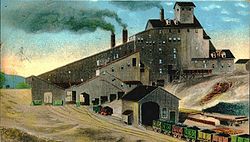
A coal breaker is a coal processing plant which breaks coal into various useful sizes. Coal breakers also remove impurities from the coal (typically slate) and deposit them into a culm dump. The coal breaker is a forerunner of the modern coal preparation plant.[1]
Coal tipples typically were used at bituminous coal mines, where removing impurities was important but sorting by size was only a secondary, minor concern.[2][3] Coal breakers were always used (with or without a tipple) at anthracite mines.[3] While tipples were used around the world, coal breakers were used primarily in the United States in the state of Pennsylvania (where, between 1800 and the mid-20th century, many of the world's known anthracite reserves were located).[4][5][6] At least one source claims that, in 1873, coal breaking plants were found only at anthracite mines in Pennsylvania.[7]
- ^ Carris, David M. "A Historic Perspective." In Designing the Coal Preparation Plant of the Future. Barbara J. Arnold, Mark S. Klima, and Peter J. Bethell, eds. Littleton, Colo.: Society for Mining, Metallurgy and Exploration, 2007. ISBN 0-87335-257-2
- ^ Cite error: The named reference
Ketchumwas invoked but never defined (see the help page). - ^ a b Cite error: The named reference
Textbookwas invoked but never defined (see the help page). - ^ Cite error: The named reference
Greenewas invoked but never defined (see the help page). - ^ Rottenberg, Dan. In the Kingdom of Coal: An American Family and the Rock That Changed the World. Florence, Ky.: Routledge, 2003. ISBN 0-415-93522-9
- ^ As of 2007, the vast majority of proven anthracite coal reserves were located primarily in Asia. The following anthracite coal producing nations held the following estimated reserves: Russia, 6,870 megatonnes (MT); China, 6,350 MT; Ukraine, 5,860 MT; Vietnam, 2,230 MT; North Korea, 1,425 MT; South Africa, 710 MT; South Korea, 240 MT; Spain, 195 MT; Canada, 100 MT; Poland, 62.5 MT; and the U.S., 50 MT. See: Marston, Richard and Ewart, Jr., Don. "Upcoming Trends in World Anthracite Trade." 2d World Anthracite Conference. Kiev, Ukraine. September 17–18, 2007.
- ^ Macfarlane, James. The Coal-Regions of America: Their Topography, Geology, and Development. New York: D. Appleton and Company, 1873.